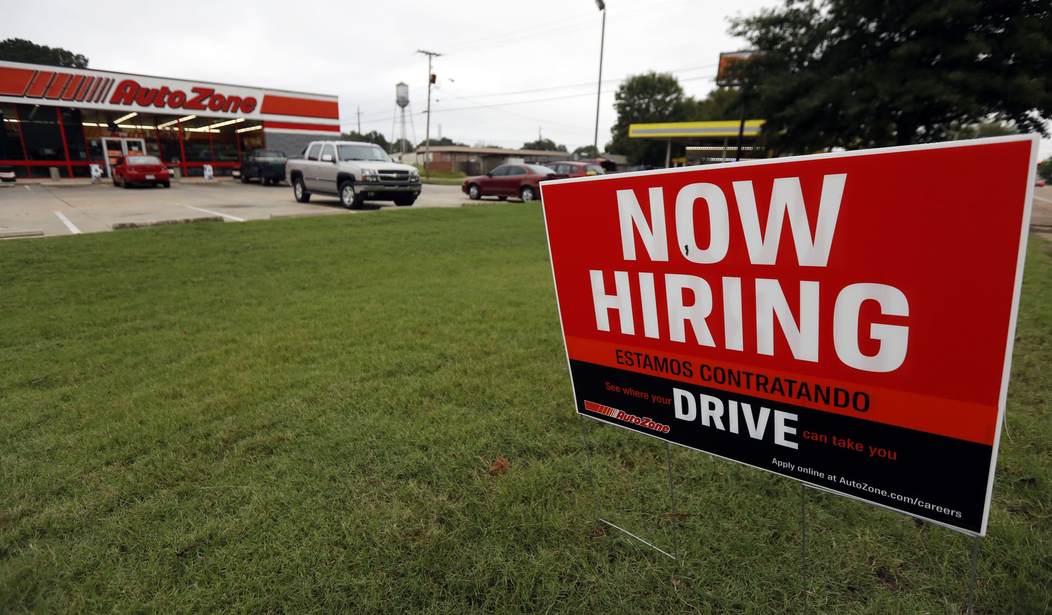Either everyone sandbagged both ADP and the White House, or no one’s really sure what’s happening with jobs numbers these days. Despite a historic crater in Wednesday’s ADP private-sector jobs report of 301,000, the Bureau of Labor Statistics reports that the US economy added 467,000 jobs in January. Unemployment remained steady at 4.0%, presumably everywhere but at ADP’s statistics shop:
Total nonfarm payroll employment rose by 467,000 in January, and the unemployment rate was little changed at 4.0 percent, the U.S. Bureau of Labor Statistics reported today. Employment growth continued in leisure and hospitality, in professional and business services, in retail trade, and in transportation and warehousing. …
Both the unemployment rate, at 4.0 percent, and the number of unemployed persons, at 6.5 million, changed little in January. Over the year, the unemployment rate is down by 2.4 percentage points, and the number of unemployed persons declined by 3.7 million. In February 2020, prior to the coronavirus (COVID-19) pandemic, the unemployment rate was 3.5 percent, and unemployed persons numbered 5.7 million.
It’s a big jump and way past expectations (more in a moment), but it didn’t get reflected in the laborforce participation metrics. Those have remained flat for quite a while, and might be related in this instance to adjustments for Omicron-related temporary restrictions:
Among the unemployed, the number of job leavers increased to 952,000 in January, following a decrease in the prior month. The number of persons on temporary layoff, at 959,000 in January, also increased over the month but is down by 1.8 million over the year. The number of permanent job losers, at 1.6 million, changed little in January but is down by 1.9 million from a year earlier. (See table A-11.)
In January, the number of persons jobless less than 5 weeks increased to 2.4 million and accounted for 37.0 percent of the total unemployed. The number of long-term unemployed (those jobless for 27 weeks or more) declined to 1.7 million. This measure is down from 4.0 million a year earlier but is 570,000 higher than in February 2020. The long-term unemployed accounted for 25.9 percent of the total unemployed in January. (See table A-12.)
After accounting for the annual adjustments to the population controls, the labor force participation rate held at 62.2 percent in January, and the employment-population ratio was little changed at 59.7 percent. Both measures are up over the year but remain below their February 2020 levels (63.4 percent and 61.2 percent, respectively).
The general thrust of the report is all in a positive direction. Wages are up again, annualized at a 5.7% growth rate. That’s still below the current inflation rate, however, and in longer-scale terms would be a sign of a burgeoning wage-price spiral, but it’s not quite spiraling yet. There were massively large revisions to previous reports for November and December totaling 699,000 added jobs, but part of that was the new methodology adjustments typically made at the beginning of each year. (Don’t forget that these are surveys, in essence polling, that depend on assumptions for the composition of a population.)
The strong report caught everyone by surprise, and not just because of ADP’s spectacularly wrong projection. The New York Times wrote a curtain-raiser designed to deflect blame from the White House this morning before the report appeared, apparently keying off the pre-release spin from the Biden team:
The January jobs report is arriving at a critical time for the U.S. economy. Inflation is rising. The pandemic is still taking a toll. And the Federal Reserve is trying to decide how best to steer the economy through a swirl of competing threats.
Unfortunately, the data, which the Labor Department will release on Friday, is unlikely to provide a clear guide.
A slew of measurement issues and data quirks will make it hard to assess exactly how the latest coronavirus wave has affected workers and businesses, or to gauge the underlying health of the labor market.
“It’s going to be a mess,” said Skanda Amarnath, executive director of Employ America, a research group.
Is it still a mess? The NYT’s Jeanna Smalek at least sees some oddities:
This is a very weird report. Huge headline number (467,000), even with a big number of people out of work due to Covid (6 million versus 3.1 million in December). Super fast wage growth (5.7 percent).
It’s tough to read through most of this report because of the methodology changes. The report doesn’t provide the month-on-month deltas for the Household report, presumably because the December-January methodology changes don’t make the deltas reliable. However, the first point that pops out to me there is a workforce expansion of nearly 1.4 million in a month — which would explain why an additional 467,000 jobs didn’t move the participation metrics. The Household data also shows 1.2 million more people employed in January than in December, which makes little sense at all, especially while the “not in labor force” numbers barely budged in relative terms (-326K).
The Establishment data is more reliable anyway, so the jobs addition numbers there are probably more solid. But it’s worth noting that BLS shows the biggest gainer in January to be Leisure and Hospitality (+151K), the same category that ADP had as the biggest loser last month.
Something’s very odd in one of these organizations. Given ADP’s generally poor track record as a reliable indicator over the last couple of years, I’m willing to bet that they’re still the issue. This jobs report doesn’t add up internally, however, literally or figuratively. If I were the White House, I’d worry about what comes out in February after the methodology quirks all get worked out.








Join the conversation as a VIP Member